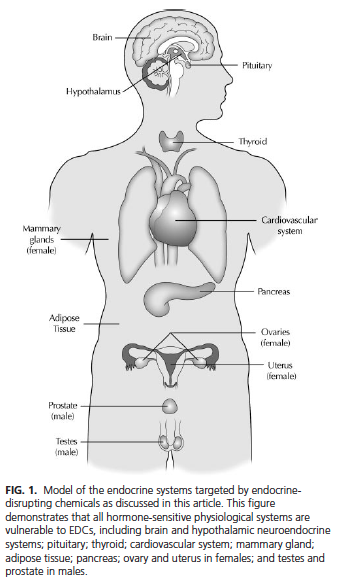The term “estrogenic” refers to hormone disrupting chemicals like BPA and other chemicals from plastics, pesticides and other sources that can affect the health of both men and women in ways that are similar to estrogen. Most hormone disruptors exhibit estrogenic action.
The Endocrine Society (www.endo-society.org) — the world’s oldest and largest organization for doctors and medical researchers who study hormones,– has issued a massive study calling hormone disruptors a “significant concern to public health.”
That study, Endocrine-Disrupting Chemicals: An Endocrine Society Scientific Statement, was funded by the National Institutes of Health and the European Commission and presented extensive data that found:
“… [E]vidence that endocrine disruptors have effects on:
- male and female reproduction,
- breast development and cancer,
- prostate cancer,
- neuroendocrinology,
- thyroid,
- metabolism and obesity, and
- cardiovascular endocrinology.”
NOTE: The previous quote was initially a long single sentence and has been re-formatted here as bullet points for easier comprehension
Truth In The Testing
It’s important to remember that there are many ways to test for estrogenic action. The ultimate test is “in vivo” (live testing), with test animals as similar to humans as possible.
There are many “in vitro” (in glass) lab tests that may find a substance estrogenic, but which may not exhibit hormone disruption in animals.
However, in vitro indications of estrogenic action are significant findings that must be taken very seriously and treated with serious precautions until EA can be confirmed or disproved in vivo.
This ad-free article is made possible by the financial support of the
Center for Research on Environmental Chemicals in Humans: a 501(c)(3) non-profit.
Please consider making a tax-deductible donation for continued biomedical research.
Estrogen In Men, Testosterone In Women?
Most people associate estrogen only with women because it plays such a striking role in sexual development, fertility, pregnancy and menopause.
However, estrogen exists in men’s bodies as well. In fact, women have levels of the male hormone, testosterone.
Testosterone is known as an androgen.
Both types of hormones and the balance between them play vital, no-sex-related roles that include:
- metabolism regulation
- fat storage
- regulation of blood cholesterol levels
- bone growth
- maintenance of skin and blood vessels,
- promotes wound healing
Significantly, your body creates estrogen from testosterone and another androgen called androstenedione. In addition to being produced in ovaries, uterus, testicles and prostate, fat tissue, the liver, muscle and brain also produce estrogen.
Estrogen and androgens exist in extremely small concentrations: parts per billion (nano-concentrations). Good health depends on your body maintaining a razor-sharp (and easily upset).
The balance of your body, the proper functioning of every organ and tissue are controlled by hormones.
Estrogenic Action = Chemicals Acting Like Estrogens
Many of the most common hormone disruptors like Bisphenol A (BPA), phthalates, pesticides and flame retardants act like artificial estrogens. Scientists call these foreign estrogens, “xenoestrogens.”
Significantly, BPA and some other artificial estrogens can also counteract testosterone. Those are known as “androgen antagonists.”
Depending upon the mixture of artificial hormones in your body, the result can be an estrogen overdose or testosterone shortage. In addition, scientists have discovered that estrogenic action can also affect the proper genetic functioning of a cell in ways that may be temporary or can be inherited by future generations.
Upsetting The Hormone Balance Invites Disease
Healthy bodies have a very sensitive system for detecting and regulating estrogen, testosterone and other hormone levels. But artificial hormones can evade your body’s hormone regulation system and in doing cause or promote cancer, Alzheimer’s Disease, obesity, type 2 diabetes, infertility and more.
The Endocrine System
Hormones control your body and are produced by glands and other tissue. All of the hormones and the glands and tissues are known as the endocrine system. Doctors (clinicians) who work with endocrine disorders are endocrinologists.
Endocrine Disrupting Compounds (EDCs) is the formal, scientific term for hormone disruptors.
Illustration below, from: Endocrine-Disrupting Chemicals: An Endocrine Society Scientific Statement. The system as illustrate shows those parts of the body most commonly disrupted by EDCs. Not shown are the adrenal glands, bones and other hormone producers.
Comments are closed.